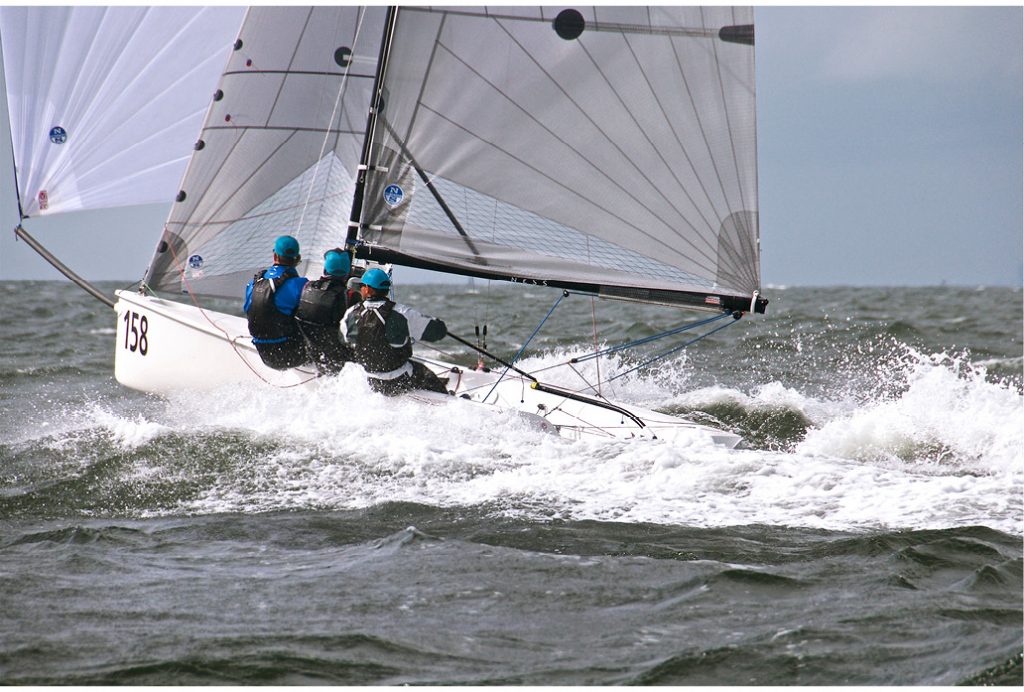On most boats, the mainsail is the biggest sail and therefore affects your upwind speed more than any other speed variable. It also has a lot to do with pointing ability. So if you are the person holding the mainsheet (whether you are the helmsperson or a dedicated mainsail trimmer), it’s important to do as good a job as possible.
Pre-race mainsail set-up
Like almost every other crew job, being a good mainsail trimmer requires practice and preparation to optimize performance. Here are some things you can and should do before the racing begins.
Telltales Place bright-colored telltales on the aft end of the top two batten pockets. These will tell you when the airflow around the upper part of the sail is stalling.
Battens Be sure the battens are inserted correctly and securely in their pockets. Use stiffer battens in heavy air and bendier, more tapered ones in light air (to avoid hard spots at their inboard ends).
Sail controls Get familiar with all your sail controls including out- haul, vang, cunningham, backstay and traveler. Know where each one leads and how to adjust it. Set up all these control lines so they are untangled, out of the way and even on each side.

On smaller boats, the main trimmer is also the helmsperson and tactician, so you must be able to adjust the main quickly without spending much time looking at it. On bigger boats, crew jobs are more specialized so the main trimmer can focus on his or her sail for almost the entire race. That can also be a problem since the main does not exist in a vacuum; you must integrate your trim with steering, tactics, jib trim, etc. © Rick Bannerot/OntheFlyPhoto.net
Halyard Hoist the halyard so the head of the main is all the way up to the black band. After sailing for a while, check the halyard again for possible stretch or slippage.
Flogging While sailing, try to minimize the amount of time your mainsail is luffing so you maintain the sail’s shape as long as possible. If you have a leech cord, set it just tight enough to eliminate flutter.
Rig tuning The main trimmer is often responsible for rig tuning as this has a large impact on mainsail shape. Make sure you have enough time before racing to check out the mast on both tacks and make any adjustments necessary.
Cleats On small boats, adjust your main camcleat so the jaws are just below the sheet when you’re holding it from a hiked-out position. You want the cam low enough so the sheet won’t cleat automatically, but high enough so you can cleat it occasionally when you want.
Tuning Before the race, spend time sailing upwind with another boat. Set up your mainsail trim, and when you are going fast, put a reference mark on the mainsheet. This is a quick guide for getting your mainsail trim in the ballpark while you are racing.
Hold it! Don’t cleat the sheet! The wind and waves are always changing and require constant adjustment of the sheet to keep the boat going fast. Plus, holding the mainsheet is one of the best ways to feel what the boat needs. ■
This article originally appeared in David Dellenbaugh’s Speed & Smarts, The newsletter of how-to tips for racing sailors. If you want to sail faster and smarter, log onto
SpeedandSmarts.com. ■
A resident of Easton, CT, Dellenbaugh was tactician and starting helmsman for America3’s successful defense of the America’s Cup in 1992. He’s a Lightning World Champion, two-time Congressional Cup winner, seven-time Thistle National Champion, two-time winner of the Canada’s Cup, three-time Prince of Wales U.S. Match Racing Champion, and a winner of the U.S. Team Racing Championships for the Hinman Trophy.




